What It Was Like To Shop At The First Costco
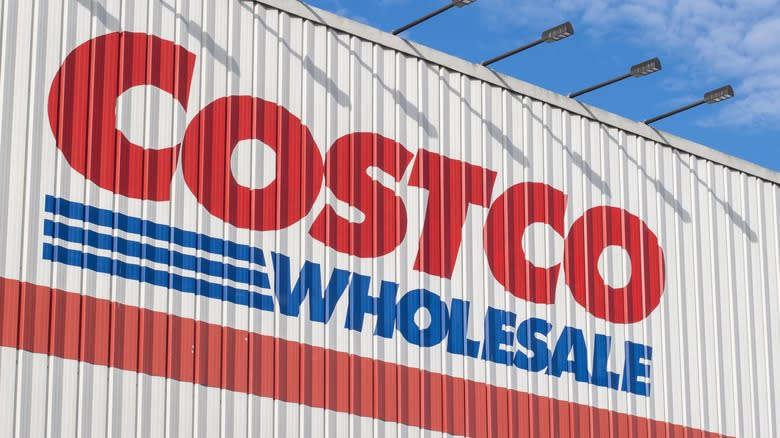
Picture your ideal Costco trip. For most of us, going to the membership-only warehouse retailer is an opportunity to leave the real world behind for a while. Bask in the fluorescent lights hanging from the stark open ceilings! Skip down long aisles bordered by towering pallets of dog food and paper towels! Revel in your $1.50 hot dog and soda combo; nosh on a Kirkland Signature egg roll sample. At the end of your visit, you wave goodbye to the friendly Costco employees, your receipt noticeably short from your hefty savings. Surely, Costco has always been this way, right?
Not exactly. When Jim Sinegal and Jeff Brotman founded Costco Wholesale in 1983, the store was years away from becoming the wholesale warehouse giant it is today. Back then, Costco was a far-fetched dream born from the success of an existing company: Price Club. But Sinegal and Brotman were determined to take Price Club's business model into daring, unexpected directions. So when Costco's first customers walked through its warehouse doors in 1983, what they saw and experienced was a far cry from what Costco customers experience today ... with some notable exceptions.
In some ways, Costco has changed since its early '80s childhood. But when it comes to Costco's core values, the company has barely moved an inch.
Read more: 14 Popular Chain Grocery Stores For Meat, Ranked Worst To Best
Price Club And Costco Were Born In The '70s And '80s

Founded by Sol Price in 1976 — yes, you read that correctly; "Price" refers to the founder's name — Price Club sold products in bulk to small business owners. Of course, anyone with a mind for profit knows that the best businesses evolve with the times, and Price definitely had a mind for profit. So did one of his former employees, Sinegal. So when Price expanded his clientele to include government agencies and nonprofits, Sinegal took note. Even a club needs to accept new members once in a while, right? Less than ten years later, Sinegal followed in Price's footsteps and co-opened the very first Costco.
If there wasn't a huge "Costco" sign above the doors, customers probably would've thought they were walking into yet another Price Club. The stripped-down, open-ceiling warehouse appearance and the membership-only rule made the two companies competitors, but they looked like siblings. Fewer than six years later, Costco was a company worth billions. It was the first company to achieve $3 billion in sales within such a short time frame, according to the warehouse retail giant. By the '90s, Costco found itself in a position where it could join forces with Price Club — a full-circle moment for Sinegal.
The First Costco Warehouse No Longer Exists
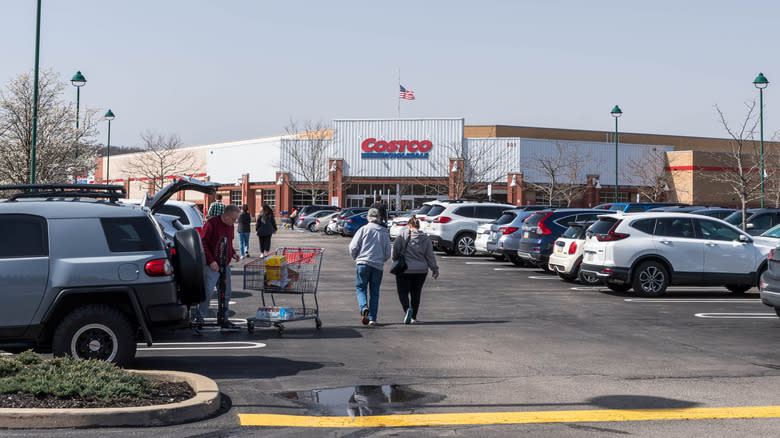
Like anything that was created in 1983, by 2005, the original Costco building was in need of a makeover. In its prime, the very first Costco operated out of a Western Marine Supply Co. store. Maybe it was big enough for a new business, but after 22 years of steady growth, Costco's big-box items were practically flowing out the doors. The store also housed Costco's corporate offices for a few years, making for an increasingly tight squeeze. The original Costco had simply outgrown itself.
But Sinegal valued loyalty. "With that membership fee, you in essence lock [customers] into shopping with you. You build that loyalty," he told ABC News in 2005. He undoubtedly felt a deep loyalty to the Seattle community that first gave his business a home. So when the school next door to the original Costco closed down, the company jumped at the chance to buy the property.
The school was torn down and replaced with a shiny (but not too shiny) new Costco, a bigger version than the original that stood next door. When a photo of the original Costco was shared on Reddit, people reminisced about how much — and how little — things have changed. "Looks like it was hard to get a good [parking] spot back then too!" one Redditor wrote.
Costco Looked More Like A Warehouse Than A Store
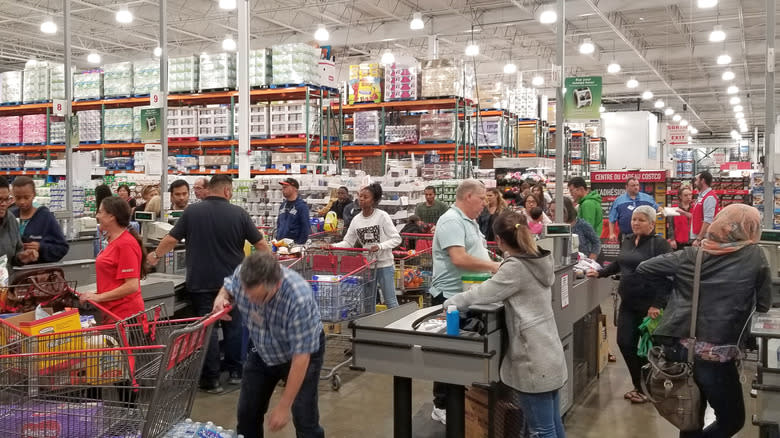
Costco hasn't changed much over the years, at least in terms of appearance. The very first Costco, which opened in Seattle in 1983, had the same fluorescent lighting, concrete floors, and pared-down decor as today's Costco warehouses. What an original advertisement described as a no-frills design was 100% intentional.
This is not only because it was more cost-efficient for the warehouse to actually look like a warehouse, but because Costco was marketed as the big-box supermarket for the everyday American. "Each member is their own salesperson. There is no high pressure selling," the advertisement claims (via Kiro 7 News). Nothing fancy, nothing gimmicky, just necessary household or retail products at a bargain price.
But one thing has changed since Costco's first store opened: Its popularity. In 2009, Sinegal told CNN Money that Costco's first week of business wasn't exactly promising. This didn't last long, however. With every passing week, sales grew by 25%. Within three months, the warehouse retailer was raking in $1.4 million per week. Costco may not have looked like a threat to other wholesale warehouses at the time, but the company's rocketing profits proved otherwise.
Only A Select Few Could Shop At Costco's First Store
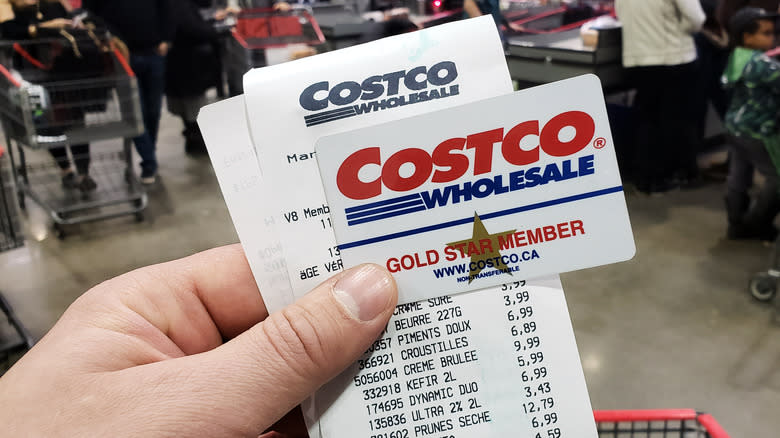
Before anyone lined up for free samples at Costco, Price Club was a fluorescent-lit haven for business owners. Costco's co-founder, Sinegal, worked as the executive vice president of merchandising, distribution, and marketing for Price Club, so it shouldn't come as a surprise that Costco adopted one of Price Club's defining traits. Back in the early days of Costco, only small business owners were granted membership.
The exclusivity of big-box stores was convenient for small business owners. As Sinegal explained to CNN Money, being able to provide everything a business may need in one location, including electronics and office supplies, was a revolutionary business model. Selling groceries and household necessities on top of business essentials only sharpened Costco's edge. At that point, Sinegal's business was competing with Price Club and another big-box membership-only store, Sam's Club, which opened the same year (1983). In order to keep its edge, Costco had to expand its membership parameters.
Costco eventually offered membership to the general public. For an annual fee of $25, the average Costco member had access to the big-bulk wonderland. Nowadays, the annual Business Membership or Gold Star membership fee has risen to $60, while Executive Membership is $120.
There Were No Food Courts To Be Found
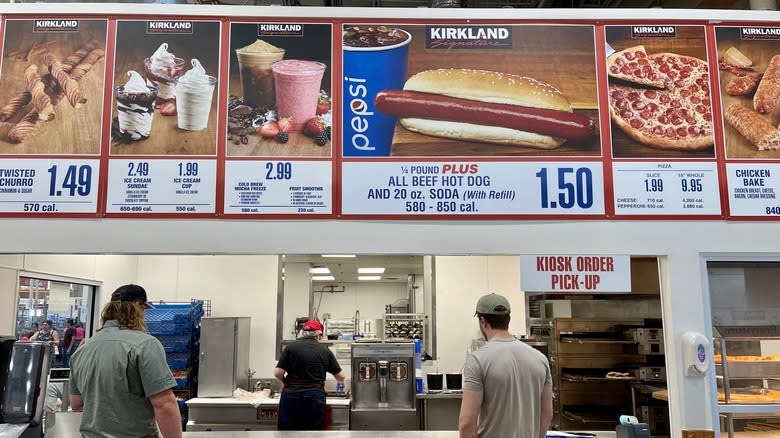
We go to Costco for groceries but leave with empty sample cups and hot dogs; It's the Costco way of life. The warehouse chain has long sold $1.50 hot dogs to hungry customers, and the low price hasn't budged since 1985.
But if you were a hungry customer at the very first Costco in 1983, you'd have been forced to leave the store with a rumbly belly. This is because Costco didn't introduce fresh hot dogs until two years after it opened. At that point, the hot dogs were served out of hot dog carts, not at a food court. Back in '83, customers weren't tempted by the scent of hot pizza and freshly baked churros. In fact, there wasn't a food court to be found in the original Costco.
Nowadays, the whopping number of hot dogs Costco sells surpasses all MLB stadiums. Costco reportedly sold 200 million hot dog/soda combos in 2023 while MLB stadiums sold only 22 million. Sinegal was once paraphrased saying he'd "kill" a former CEO who floated the possibility of raising the price of Costco's hot dogs. We hope that Costco's executives have as much passion for the retailer's other popular food court items, from Polish dogs to chicken bakes and chocolate chip cookies.
An Early Advertisement Listed Unique Items For Sale
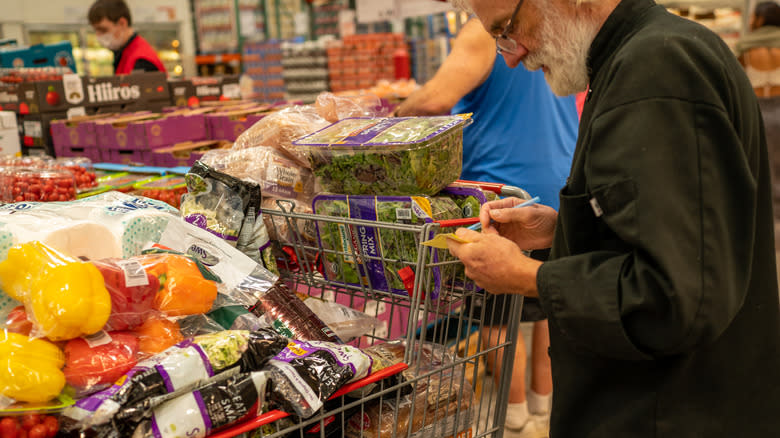
You never really know what you'll find when shopping at Costco, and the retailer's hidden gems are one of its biggest assets. From premium beef to televisions to baby formula, Costco's vast offerings are half the draw. It was the same way back in the '80s.
Even early advertisements emphasized the store's diverse stock. In an advertisement from the '80s, Costco hawked items you'd probably never find on shelves today: Typewriters, for instance, instead of laptops or tablets. Stereos in all their booming, clunky glory were also advertised. Most surprising (and disturbing) is the advertisement for cigarettes, which customers could buy at Costco while allegedly experiencing "dramatic savings."
Costco didn't start pulling cigarettes from its shelves until 2016. By then, cigarettes weren't only a well-known health hazard, but a business hazard as well for some companies. As a Costco spokesperson explained to Money, tobacco products like cigarettes aren't usually sold for much more money than they're worth. He pointed out that cigarettes are stolen more than other products, too.
Another outdated feature of the original Costco? Customers could only pay with cash or a check. Nowadays, you can pay for your Costco haul with everything from Apple Pay to EBT cards to traveler's checks. So time hasn't only changed the products Costco sells, but how one pays for them, too.
The Warehouse Offered High-Quality Items At An Affordable Price
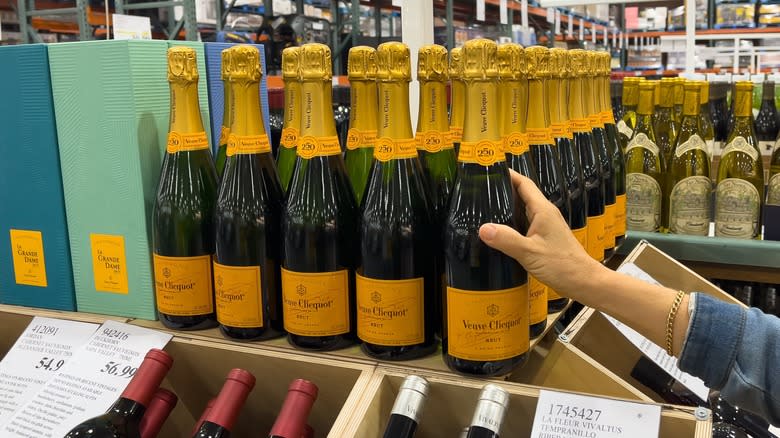
Seasoned Costco customers aren't fooled by the unpretentious warehouse design. Costco is filled with luxury items; its most expensive foods range from $949 cheese to $1,999 caviar. But it's also home to high-quality items at an affordable price.
Sinegal once reflected on the goals he set in motion when he opened the very first Costco. He told Sacred Heart University about a fateful decision he made in the '80s: "We were going to guarantee every single product that we carried unconditionally ... we were not going to carry any seconds or irregulars or poor quality merchandise," he said. Providing high-quality products at low prices falls under Costco's Code of Ethics. In vowing to take care of customers, Costco pledges to sell only the highest-quality items.
But how has Costco kept its prices lower than other retailers? While most supermarkets carry at least 30,000 units of stock, Costco only carries 4,000. This is meant to ensure that every item sold at Costco is of the highest possible quality, and from the best possible supplier. It's up to those with a membership to decide for themselves if the products live up to this lofty ideal.
Employee Support Was Established At The Very First Costco
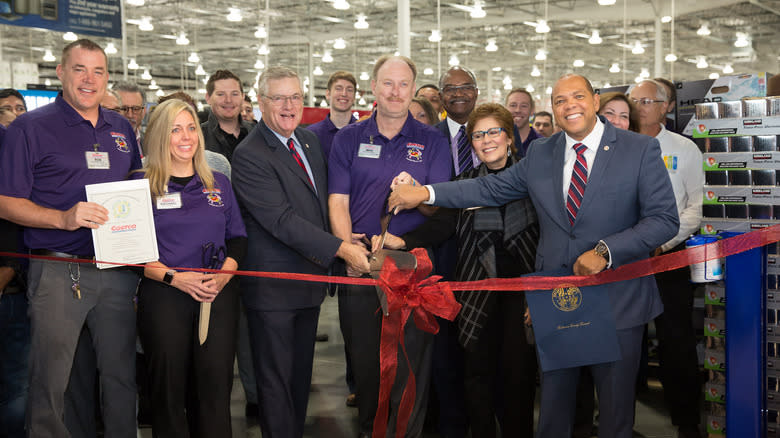
Sol Price had a bold idea: To retain employees by paying them a livable wage and offering comprehensive health benefits. This sounds like a no-brainer, but as many retail and grocery workers could tell you, living wages are few and far between. Paying employees a decent salary meant that Price didn't see revenues in the billions, but it was a small price to pay for reliable, loyal workers. Sinegal took a leaf out of Price's business book when he resolved to pay Costco employees fairly.
"We were not going to have anybody claim or suggest that the only way that we were profitable was because we were making money off the backs of our employees and that we were not paying them properly," Sinegal told Sacred Heart University. To take care of employees is a core part of Costco's Code of Ethics. Costco ranked at #61 out of 600 on Forbes' 2024 list of America's Best Large Employers, so it must be doing something right.
Costco makes an effort to promote almost entirely within its own ranks, Sinegal told ABC News 2005. And according to the former CEO, it's not unusual for employees who were hired in the '80s to stick around for years to come. Now that's loyalty.
The Great Warehouse Merger Of 1993
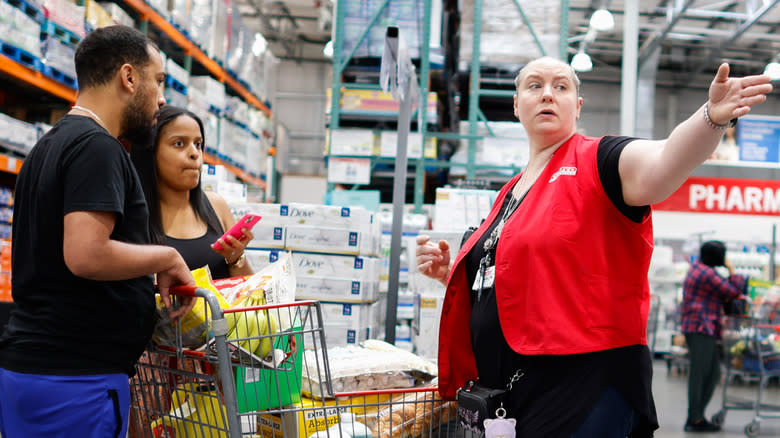
Price created a big-bulk warehouse empire with Price Club, but by the time the '90s rolled around, it was tough keeping up with competitors like Sam's Club and Costco. Thus began the war of the warehouses. As Price confirmed to Fortune Magazine in 2003, Sam's Club — an off-shoot of Wal-Mart — had once tried to buy Price Club, but Price declined the offer. "We were good at innovating, but when it came to expanding and controlling, we weren't so good," he admitted. But by 1993, it was clear that Costco — the small warehouse store that had evolved into a chain over time — wasn't going anywhere.
In fact, the chain, co-owned by Price's one-time employee Sinegal, was only gaining momentum. So when the duo talked business in 1993, merging was the obvious path forward. Every Costco location, including the very first one, was renamed PriceCostco. An employee who had worked at Price Club since 1984 told Business Insider about the red (Costco) vs. blue (Price Club) mentality that employees experienced during the merger. "The first thing the folks at the warehouse would ask me is, 'Are you red or blue?'"
Employees who had worked at Costco since '83 were suddenly working alongside their former competitors. Just a few years later, the wholesale retailer dropped "Price" from its name and was once again known as "Costco", putting an end to the war of the warehouses ... at least between Price Club and Costco.
The First Costco Was Home To Tom The Guessing Doorman
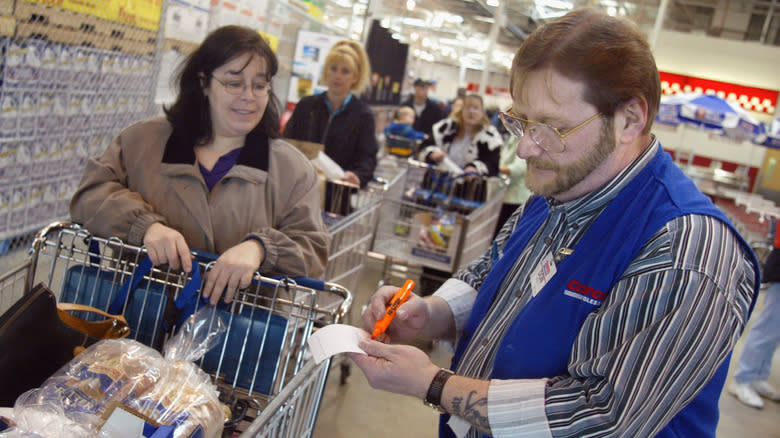
Ask anyone who has ever worked a customer-facing job: It isn't easy, usually because the hours, pay, and benefits are usually far below what they probably should be. But Costco has long broken the mold when it comes to employee support, and the benefits of an employee-first business structure were never more clear than when one of Costco's own employees became an internet sensation. The employee, known as Tom the Guessing Doorman, was a fixture at the very first Costco since 1994. He'd check receipts at the door, and before glancing at the total, he'd guess the price — and somehow, he was almost always right on the money.
His talent for guessing customers' grocery totals made him popular, and even then-CEO Sinegal referred to Tom as Costco's goodwill ambassador, according to the Seattle Times. So when Tom suddenly disappeared from the Seattle Costco location, customers were worried. Thankfully, the Seattle Times tracked him down to Arizona, where he'd moved for health reasons. Tom the Guessing Doorman was still up to his impressive price-guessing tricks as of 2017.
How Kirkland Signature Was Born
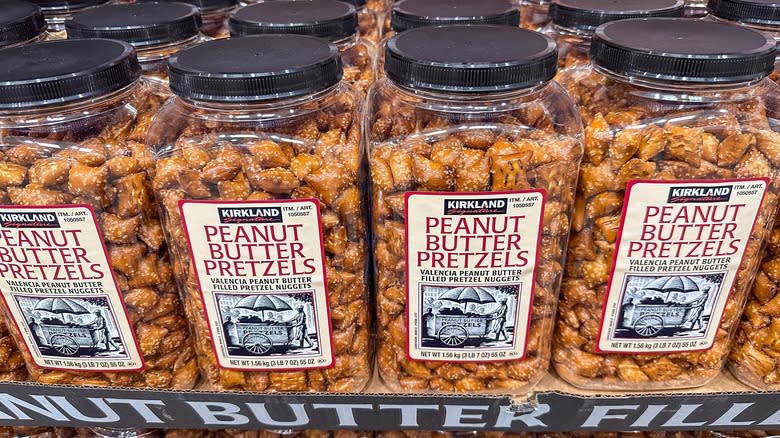
When we think of Costco, we think Kirkland Signature. The brand has been synonymous with the warehouse chain since it was first introduced. We can't imagine shopping in Costco without the fancy Kirkland Signature logo shining off the shelves from wine bottles and pretzel jars. But customers in the very first Costco wouldn't have come across Kirkland Signature items at all.
In fact, it was another 10+ years before Costco added Kirkland Signature products to its shelves in 1995. Why did it take so long for Costco to introduce its own exclusive private label, and why has it been so successful? After all, Costco has long pledged to sell high-quality products at a low price; the words "exclusive" and "private label" don't exactly scream "affordable," even for a membership-only store.
Well, Costco's Kirkland Signature isn't just a cheap knockoff brand, as scores of Kirkland fans on Reddit could tell you. They've praised a wide variety of Kirkland products, from ice cream to vodka to plastic wrap. "The super premium vanilla ice cream is unbeatable," one Redditor wrote. "Kirkland Stretch Wrap, hands down the easiest to handle and strong to boot," another Reddit user claimed. There's Kirkland dog food, baby products, gasoline... the list goes on. Shopping in Costco in the '80s may have been convenient and cost-effective, but without Kirkland products, was it really any fun?
Read the original article on Tasting Table


